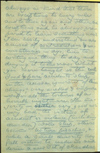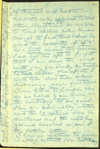Mahatma Letter No. 76
| Quick Facts | |
|---|---|
| People involved | |
| Written by: | A. P. Sinnett/Koot Hoomi |
| Received by: | Koot Hoomi/A. P. Sinnett |
| Sent via: | unknown |
| Dates | |
| Written on: | APS wrote KH on August 12, 1882 |
| Received on: | KH response arrived August 22, 1882 |
| Other dates: | unknown |
| Places | |
| Sent from: | unknown |
| Received at: | Simla, India |
| Via: | unknown |
This is Letter No. 76 in The Mahatma Letters to A. P. Sinnett, 4th chronological edition. It corresponds to Letter No. 21 in Barker numbering. See below for Context and background.
Words in bold are precipitated in blue on Mr. Sinnett's original letter.
< Prev letter chrono
Next letter chrono >
< Prev letter Barker
Next letter Barker >
Page 1 transcription, image, and notes
|
BOLD text represents the K.H. responses to Sinnett's questions and comments. August 12th. My dear Guardian, I am afraid the present letters on Theosophy are not worth much, for I have worked on too literal an acceptance of some passages in your long letter about Deva-Chan. The bearing of that seemed to be that the "accidents" as well as the suicides, were in danger from the attraction of the seance room. You wrote: — "But there is another kind of spirit we have lost sight of, — the suicides and those killed by accidents. Both kinds can communicate and both have to pay dearly for |
|
NOTES: |
Page 2
|
such visits. . . ." Correct. "As to the victims of accident these fare still worse . . . unhappy shades . . . cut off in the full flush of earthly passions . . . they are the pisachas etc. . . ." They not only ruin their victims etc. . . ." Again correct. Bear in mind that the exceptions enforce the rule. And if they are neither very good nor very bad the "victims of accident or violence," derive a new set of skandhas from the medium who attracts them. I have explained the situation on the margin of proofs. See note. It was on this text that I have been working. If this is not to be maintained or if in some way that as yet I cannot understand the |
NOTES: |
Page 3
|
words bear a different signification from that which seems to belong to them, it might be better to cancel these two letters altogether or hold them over for complete alteration. The warning is delivered in too solemn a tone and the danger is made too much of if it is merely to apply to suicides, and in the last slip of the proof the elimination of "the accidents and" makes the rest rather ridiculous because then we are dividing suicides only into the very pure and elevated! and the medium people etc. It seems to me that it would hardly do to let even letter 1 stand alone, — though it does not include the |
NOTES:
|
Page 4
|
mistake, for it would have no raison d'etre unless followed up by letter 2. Both letters have gone home to Stainton Moses for transmission to Light — the first by the mail from here of July 21, the second by last mail — yesterday. Now if you decide that it is better to stop and cancel them I shall just be in time to telegraph home to Stainton Moses to that effect, and will do this directly I receive a telegram from you or from the Old Lady to that effect. If nothing is done they will appear in Light as written — i.e. as the MS. sent with the present proof stood barring a few little mistakes which I |
NOTES:
|
Page 5
|
see my wife has made in copying them out. It is altogether a very awkward tangle. I was precipitate apparently in sending them home, but I thought I had followed the statements of your long devachan letter so faithfully. Awaiting orders, Ever your devoted On margin I said "rarely" but I have not pronounced the word "never." Accidents occur under the most various circumstances; and men are not only killed accidentally, or die as suicides but are also murdered— something we have not even touched upon. I can well understand your perplexity but can hardly help you. Bear |
NOTES: |
Page 6
|
always in mind that there are exceptions to every rule, and to these again and other side exceptions, and be always prepared to learn something new. I can easily understand we are accused of contradictions and inconsistencies — aye, even to writing one thing to-day and denying it to-morrow. What you were taught is the RULE. Good and pure "accidents" sleep in the Akasa, ignorant of their change; very wicked and impure — suffer all the tortures of a horrible nightmare. The majority — neither very good nor very bad, the victims of accident or violence (including murder) — some sleep, others become Nature pisachas, and while a small minority may fall victims to mediums and derive a new set of skandhas |
NOTES: |
Page 7
|
from the medium who attracts them. Small as their number may be, their fate is to be the most deplored. What I said in my notes on your MSS. was in reply to Mr. Hume's statistical calculations which led him to infer that "there were more Spirits than shells in the seance rooms" in such a case. You have much to learn — and we have much to teach nor do we refuse to go to the very end. But we must really beg that you should not jump at hasty conclusions. I do not blame you, my dear faithful friend, I would rather blame myself, were anyone here to be blamed except our respective modes |
NOTES: |
Page 8
|
of thought and habits so diametrically opposed to each other. Accustomed as we are to teach chelas who know enough to find themselves beyond the necessity of "if's " and "but's" during the lessons — I am but too apt to forget that I am doing the work with you generally entrusted to these chelas. Henceforth, I will take more time when answering your questions. Your letters to London can do no harm, and are sure, on the contrary to do good. They are admirably written and the exceptions may be mentioned and the whole ground covered in one of the future letters. I have no objection to your making extracts for Colonel Chesney |
|
NOTES: |
Page 9
|
— except one — he is not a Theosophist. Only be careful, and do not forget your details and exceptions whenever you explain your rules. Remember still: even in the case of suicides there are many who will never allow themselves to be drawn into the vortex of mediumship, and pray do not accuse me of "inconsistency" or contradiction when we come to that point. Could you but know how I write my letters and the time I am enabled to give to them, perchance you would feel less critical if not exacting. Well, and how do you like Djual Khool's idea and art? I have not caught a glimpse of Simla for the last ten days. Affectionately yours, |
|
NOTES:
|
Context and background
Letter No. 76 concerns some articles, or "letters" which A. P. Sinnett had written and sent to Stainton Moses in London for publication in Light, the spiritualist magazine edited by Moses. They were entitled "Letters in Esoteric Theosophy, from an Anglo-Indian to a London Theosophist." They were published in the September 1882 issue of Light.
These articles were written by Sinnett following receipt of the long "Devachan" letter, which had a great deal to say about spiritualism, suicides, accidents, and so on. After sending them, Sinnett received Mahatma Letter No. 71, where some of his understanding was corrected. The current letter is Sinnett's response, with comments added by Mahatma KH.
Physical description of letter
The original is in the British Library, Folio 1. George Linton and Virginia Hanson wrote this description:
A letter from APS to KH on two sheets of his usual small note paper. It was returned by KH with marginal comments and an added note. The answer is on the back of APS's sheets and additional sheets of a different type of paper, in blue pencil, having a grained appearance.[1]
Publication history
Commentary about this letter
K.H. portrait
In reference to the production of the portrait, Sinnett wrote in his book The Occult World:
- "Now in aspiring to have a portrait of Koot Hoomi, of course I was wishing for a precipitated picture, and it would seem that just before a recent visit Madame Blavatsky paid to Allahabad, something must have been said to her about a possibility that this wish of mine might be gratified. For the day she came she asked me to give her a piece of thick white paper and mark it. This she would leave in her scrap-book, and there was reason to hope that a certain highly advanced chela, or pupil, of Koot Hoomi's, not a full adept himself as yet, but far on the road to that condition, would do what was necessary to produce the portrait."
They put a piece of thick paper, marked by Sinnett, in Blavatsky's scrapbook, and was regularly inspected throughout the day. The next day,
- "After breakfast we looked into the scrap-book, and on my marked sheet of paper, which had been seen blank by my wife an hour or two before, was a precipitated profile portrait. The face itself was left white, with only a few touches within the limits of the space it occupied; but the rest of the paper all round it was covered with cloudy blue shading. Slight as the method was by which the result was produced, the outline of the face was perfectly well-defined, and its expression as vividly rendered as would have been possible with a finished picture.
- At first Madame Blavatsky was dissatisfied with the sketch. Knowing the original personally, she could appreciate its deficiencies; but though I should have welcomed a more finished portrait, I was sufficiently pleased with the one I had. . ."
Notes
- ↑ George E. Linton and Virginia Hanson, eds., Readers Guide to The Mahatma Letters to A. P. Sinnett (Adyar, Chennai, India: Theosophical Publishing House, 1972), 129.








